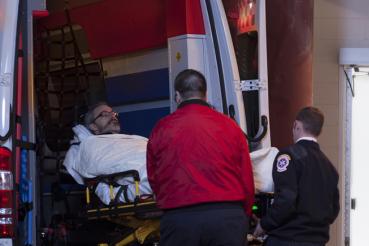(CHICAGO) – The doors to the new, state-of-the-art emergency center at 1653 W. Congress Parkway will be the first to “open in the new hospital building at Rush University Medical Center at 6 a.m. CT on Friday, Jan. 6. Rush’s current emergency department will close early Friday morning when the department goes on bypass during the move to the new facility.
The Robert R. McCormick Foundation Center for Advanced Emergency Response, which encompasses the emergency department, is the first of its kind.
“The center brings an unprecedented level of preparedness to Chicago in the event of a bioterrorist attack, a deadly pandemic or an industrial accident sending hazardous materials seeping into the streets,” said Dr. Dino Rumoro, chairman of emergency medicine at Rush.
The center houses an expanded emergency department with 60 treatment bays and with a surge capacity of 133 percent. The 40,000 square foot center is located on the ground floor of the new, 14-story hospital building at Rush on the corner of Ashland and Harrison avenues. Inpatients currently at Rush will move into the new hospital building on Sunday, Jan. 8.
“Our goal is to do what hospitals all over the country have been trying to do for years: give patients a place to go in a large-scale emergency,” said Rumoro. “The concept of the new emergency room is not that novel, but putting together all the key elements of this center is novel. In an event of an emergency, we will closely coordinate all of our work with neighboring institutions and the City’s office of emergency management and communications."
The center contains three interconnected pods or sections, each capable of isolation that helps prevent the spread of disease. There are also designated individual isolation patient rooms within each pod. Airflow in the patient rooms, the pods and even entire sections in the patient tower can be controlled to help prevent the spread of infectious agents.
While traditional emergency rooms have “pop-up” decontamination areas and showers, the center at Rush has decontamination showers built into the new emergency facility. In the event of a large-scale emergency, the enclosed ambulance bay can be converted into a large decontamination room where a water curtain can be created with hydrants to wash off patients before they enter the facility. In a mass casualty, chemical-based industrial accident or terrorism attack, Rush will be able to serve and decontaminate several hundreds of patients at once.
Large storage tanks with a capacity of 10,000 gallons are built beneath the ambulance bay to collect contaminated run-off water from patients. This prevents the water used to wash off contaminated patients from seeping into the city’s sewer system.
“Since we are committed to providing unprecedented disaster response and due to our affiliation with the military, being able to conduct coordinated large-scale decontamination inside and outside the hospital is a major public health responsibility,” said Rumoro.
The idea behind the new emergency response center goes back to the terrorist attacks on September 11, 2001, when doctors and emergency responders were forced to change the definition of a mass casualty. Mass casualties have traditionally been defined as traumas like vehicle accident injuries, and gunshot and stab wounds. After 9/11, the definition of a mass casualty was expanded by the emergency services profession to encompass such injuries as inhalation problems, burns, and the entire body being crushed. The anthrax attacks in 2001 also changed the way emergency response is now viewed.
Even the adjacent new Edward A. Brennan Entry Pavilion, which is the main lobby of the new hospital building at Rush, also can be converted into a treatment area because necessary medical gases and electrical access lines were built into the lobby’s support columns.
The new facility will utilize an advanced new software program developed by Rush emergency physicians that analyzes patient data continuously from Rush and other area hospitals to help identify potential health threats before they spread. Unusual symptoms and patterns of admission are flagged in real time by the computer program.
On a daily basis, the new facility will stand as a traditional emergency room. The larger patient rooms better accommodate family members or others and include sliding glass doors for privacy and a television. In the event of a disaster, each room has been designed to easily convert to accommodate two patients. Patients also can receive radiology services in the emergency department rather than traveling to another part of the hospital. The waiting room includes a separate pediatric area for children and their families.
Rush received a $7.5 million grant from the Robert R. McCormick Foundation, grants from other agencies such as the Department of Energy and the Department of Defense, and private contributions, to build the new Center.
The Robert R. McCormick Center for Advanced Emergency Response at Rush is part of the $654 million new hospital building called the Tower, which has 304 individual adult and critical care beds on the top five floors within the Herb Family Acute and Critical Care Tower. Rush will have a total 664 beds in operation across the existing and new facilities.
The Tower is the major component of Rush’s 10-year, $1 billion campus redevelopment project called the Rush Transformation, which blends new construction, renovations of select campus buildings and investments in leading technology that includes a comprehensive electronic health information system. It is the largest capital project in Rush’s 174-year history.
For more information, please go to http://transforming.rush.edu
Rush is a not-for-profit academic medical center comprising Rush University Medical Center, Rush University, Rush Oak Park Hospital and Rush Health.
Rush’s mission is to provide the best possible care for its patients. Educating tomorrow’s health care professional, researching new and more advanced treatment options, transforming its facilities and investing in new technologies—all are undertaken with the drive to improve patient care now, and for the future.



